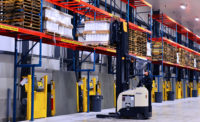Automated solutions are a familiar sight in the majority of refrigerated and frozen food warehouses. Most companies, such as those in the ice cream market, have installed automated storage and retrieval systems (AS/RS) to rapidly move products to and from storage. This optimizes the movement of goods, and saves warehouse staff from the need to brave the cold and move through aisles retrieving products.
However, an AS/RS does not eliminate people from the picture. Normally, these systems will transport goods to a temperature-controlled environment for manual picking and order fulfillment by warehouse staff. While the temperatures in these picking areas are slightly more tolerable, employees still need to bundle up and work in cumbersome conditions.
With staff needing frequent warm-up breaks, it quickly creates inefficiencies in fulfillment. On top of that, facilities are managing an expanding number of SKUs and more frequent orders and dealing with an already shrinking number of available employees. There is certainly room for improvement, which automated order picking can help fill.
A growing number of orders, but who can pick them?
Today’s consumers are continuing to gravitate toward refrigerated and frozen foods, including prepared meals, organic and vegan offerings and frozen fruits and vegetables, due in part to their convenience and longer shelf life. According to a 2018 Bloomberg article, frozen food buying is steadily growing for the first time in five years. The article shows reports from Nielsen that estimate annual U.S. sales of frozen food will reach $53 billion this year. With increased demand comes increased order numbers, and the need for pickers to fill those orders.
Despite a number of job openings, many facilities are dealing with significant labor shortage – a common thread among warehouses in virtually every industry. Older, seasoned warehouse staff members are gradually retiring. Recognizing the laborious conditions in manual warehousing facilities, the younger generation entering the workforce is showing little interest in these positions.
Traditionally, the temperature in a true freezer is close to -50°F. Even with an AS/RS, products are brought out into manual picking areas, where cold air is consistently blowing to make sure products are always in an acceptable temperature. A staff member can easily catch frostbite. Many have to take frequent breaks to warm up between the picking of orders. These conditions not only pose potential long-term harm to employees, but also slow down overall productivity and material flow.
The benefits of automated order picking
Instead, refrigerated and frozen food facilities can consider automating their order picking process with a layer picking solution, which addresses the challenges in labor shortage and optimizes fulfillment. A layer picking solution combines fast gantry robots with a clamp gripper and vacuum picking head to pick from stacked pallets on the warehouse floor. Using varying force and vacuum strength based on the SKU that it is picking, the system can pick up virtually any refrigerated or frozen food product in large, layered quantities.
Using an overhead design, a single machine can access a large portion of a facility’s inventory. The system stages every SKU within the gantry robot’s cell and can create customer orders in any sequence – it can create one layer, multiple layers, entire pallet loads and rainbow pallets. These systems run at high speeds and without break, optimizing overall productivity in the warehouse.
The speed and flexibility of a layer picking system makes it an ideal solution for warehouses struggling to keep up with large volumes of frequent orders coming from retailers during peak periods. It can even enable just-in-time order fulfillment to optimize the flow of goods. Facilities can quickly fulfill incoming orders – no matter how complex they are – with 100% accuracy and keep store shelves well stocked, even in the busiest times of the year.
In warehouses with products stored in cases, boxes or cartons, a mini-load system can help pick loads of products less than 220 pounds. A compact solution ideal for smaller, fast jobs, a mini-load system uses high-speed cranes that travel vertically and horizontally in high-density storage areas to pick products. Facilities with both products in layers and cases can use a layer picking system in tandem with their mini-load system – then combine orders at the end.
For warehousing facilities challenged with small teams of staff, an automated system can also fill the gaps left by insufficient staffing. Managers can limit human intervention to supervisory tasks, such as picking sequence selection, transport planning and general maintenance. As a result, employees are no longer responsible for manual picking, besides products that may have special handling requirements. Managers can reallocate people to these new, valuable supervising positions. It can be a draw for younger members of the workforce, who are more inclined to apply for high-tech positions.
Consumer demand for refrigerated and frozen foods shows no sign of wavering. Therefore, warehouses currently struggling to keep up with their order volume and dealing with labor shortages will need help moving forward. The facilities that choose to automate now will be poised to successfully meet rising demand with rapid, accurate and scalable order picking operations.



